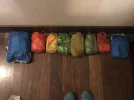Sorry to disagree, but . . .
Unless you move to only a liner or a high-end down quilt, a normal hiker's sleeping bag will be above 500g. One's clothing roll for the next day (shirt, pants, tee, socks, underwear) will likely be 1-2 kg. Sufficient water will likely vary from 1-2kg as well.
Also, there are no reputable sources that I have ever seen that recommend putting heaviest items at the bottom. All of them (from boy scouts, to military, to backpacking experts) recommend packing heavier weight in the middle to top, with the lightest high bulk items on bottom. This has to do with reducing the impact on one's center of gravity to minimize walking distortion. At lower weights, it's less of an issue than at higher weights, but the guidance still appears even in ultralight backpacking forums and resources.
And not all soap is made equal. Real and material differences do exist.
@koilife, I'm sorry, but I have to agree with you here. There are two key issues for me, reducing the leverage on my shoulders by packing heavier items close to my back, and ensuring the things I will need during the day or in an emergency are accessible.
An added complexity is the structure of the pack. I know my packing plan varies a little depending on the pack I am using. A single bag design with just a 'brain' presents a few more challenges than the packs that I have with seperate bottom pockets and those with side pockets as well.
I use a water bladder, so it gets into my pack first, closest to my back. I have walked with my water bladder in a day pack attached to my main pack. This did make my water more accessible, but as you observe, increased the distance from my back, adding to the leverage it exerted on my shoulders and back. I won't do that again.
After water, my wet bag is the next heaviest and densist item, and it is always a bit of a conundrum. I have actually taken to leaving it until late in the sequence, but also getting it as close to my back as possible. This allows me to attend to thinks like dental hygiene right up to when I leave an albergue. The other heavy item is my support pack - chargers, spare batteries, power bank, and spare cord, a few cable ties. This can go anywhere, and normally gets packed pretty early in the sequence - I hope not to need this during the day.
After dealing with dense/heavy items, the remainder is really a matter of accessibility, and packing things that I will want to use while walking in the more accessible parts of the pack. I pack clothing into large plastic ziploc bags or some of the new, very light half-size packing cubes. My sleeping bag and liner get scrunched into a waterproof compression sack, and my 'evening shoes' are left loose. I might use a ziploc bag for my fleece, but normally wear that in the morning anyhow, and just shove it into the top of the pack when I take it off.
On that basis, if I am using a single compartment pack, I would normally pack in the sequence:
- water bladder in the sleeve inside the pack,
- non essential documents (in a large ziploc bag) also in the sleeve
- spare shoes at the bottom
- sleeping bag, etc in a compression sack
- support bag close my back, held there by
- clothing bags
- wet bag close to my back, with my food bag outside it
- rain jacket and rain pants
- fleece if I am not wearing it to start the day
- rain cover pushed into a space but still accessible without having to unpack
- first aid kit also pushed into a space but still accessible
- sunscreen, insect repellant, torch, snack bars, hydration salts, gloves, buff/beanie, head net, guidebook/credencial all go into the pack 'brain' if possible. If the waist belt has side pouches, I use one side for snacks.
When I have bought more than one day's snacks or other food, I will normally distribute the individual items around the pack where there is a convenient gap between larger items.
As for soap, I normally bring a bar of laundry soap for clothes and a small bottle of wilderness wash for myself. I also know that one or other, or both, will get left behind at some point, and I will try and find a bar of plain, non-scented soap. I cannot abide the idea of artificially making myself smell like I have been rolling around in a pine forest or a field of frangipanies, nor am I in favour of anti-perspirants clogging up my sweat glands.





















